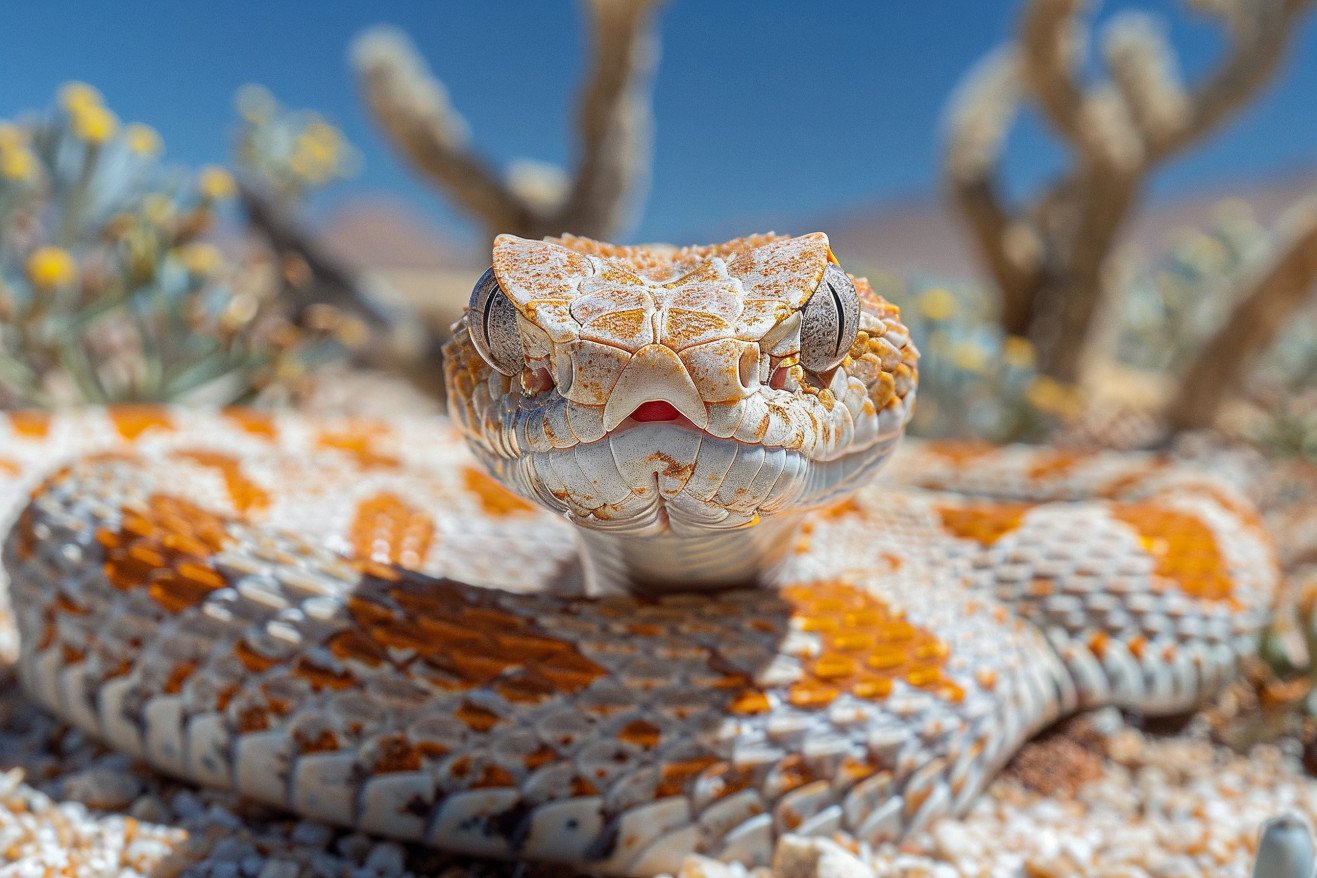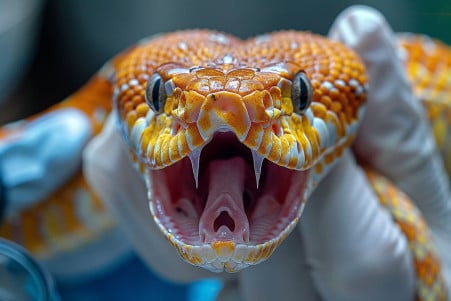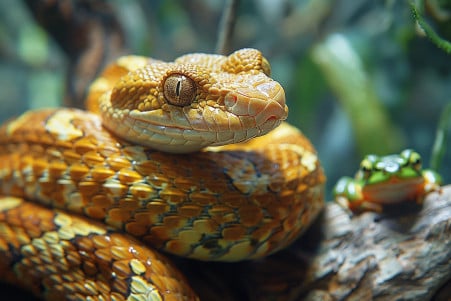Do Hognose Snakes Have Venom? Exploring the Mild Mystery
8 March 2024 • Updated 7 March 2024

Hognose snakes are known for their charming yet mysterious nature, but just how venomous are they? Hognose snakes have mildly venomous saliva that is most effective against their prey, which includes amphibians. That said, their venom is not known to be harmful to humans, and bites are generally associated with only mild symptoms. With rear fangs and a non-aggressive temperament, hognose snakes are considered to be low risk to humans.
In this article, we will look at biological and herpetological research to explore the venomous properties of hognose snakes and their role in their ecosystem. We will also look at how their venom works in relation to their prey and what this means for human interactions.
By taking a multidisciplinary approach, we hope to shed light on the potency of their venom and its role in their ecosystem, offering a well-rounded look at these interesting animals in their natural environment.
Do hognose snakes have venom?
Hognose Snake Venom: Weak but Efficient
Venom is a specialized secretion used by a number of animal species, including snakes, for defense and to immobilize prey.
Hognose snakes are venomous in the strictest sense of the word, and the venom they produce in their Duvernoy’s glands is delivered through their modified dentition to help them subdue amphibious prey.
As The Venom Interviews notes, all venom, including that of hognose snakes, is basically saliva that has been modified in a way that makes it different from normal saliva. Hognose snakes have rear fangs that the venom runs along, not through, so they have to chew to effectively inject the venom.
Even though this venom is tailored to work on their prey, it has a relatively weak effect on humans. According to a case study in the Journal of Cutaneous Immunology and Allergy, symptoms of a hognose snake bite can include swelling, redness, and blister formation, but these are not life-threatening and will resolve with time.
A study in PMC lists potential symptoms of a bite as localized pain and swelling, but it notes that these are usually mild, confirming that hognose snakes, despite being venomous, aren’t a threat to humans.
Knowing that hognose snake venom has a relatively weak effect on humans can help dispel some of the myths and misconceptions about these animals and show how they’ve evolved to fill a unique niche in the ecosystem.
Hognose Snake Venom and Prey Dynamics
Hognose snakes have specialized in eating amphibians, especially toads, and they use their mild, amphibian-specific venom to immobilize their prey. Animalia.bio explains that hognose snakes have also adapted a clever way to pop toads that have puffed themselves up in defense by using their upturned snouts to pop them, making them easier to eat. This specialization not only demonstrates their adaptability but also their role as a natural regulator of amphibian populations.
Their venom, which is harmless to humans, is highly effective against their prey, which has few defenses against hognose snakes. The Maryland Zoo in Baltimore explains that hognose snakes are immune to toad toxins, which suggests an evolutionary arms race between predator and prey. By regulating amphibian populations, hognose snakes help maintain an important ecological balance that ensures their prey doesn’t overrun their local environment.
ReptiFiles explains that hognose snakes’ diet isn’t limited to toads, however, and also includes frogs, salamanders, and even small reptiles and rodents. This versatility in their diet shows their significance in their ecosystems as both predators and occasional prey. Studying the connection between hognose snakes and their prey helps scientists better comprehend their ecological niche and the role of their venom within the complex network of nature’s food web.
The Art of Defense: Hognose Snakes’ Bluff and Venom Tactics
Hognose snakes have a variety of defensive behaviors that they use to surprise and confuse predators. According to the Indiana Department of Natural Resources, these behaviors can include inflating their bodies, spreading their necks to look like a cobra, and hissing.
If these tactics don’t work, the Eastern hog-nosed snake, for example, will then dramatically play dead by flipping over on its back and laying still with its mouth open and tongue hanging out. This behavior has also been observed in hatchlings by Brenda S. Hemken.
The use of venom in these defense mechanisms is complex. ReptiFiles explains that while North American hognose snakes have rear fangs and venom, the venom is only slightly toxic to humans, making it relatively harmless. This suggests that venom isn’t the snakes’ first line of defense.
Instead, they rely on bluffing, which may be because their venom isn’t strong enough to deter larger predators. While the success of these tactics in the wild hasn’t been well-documented, the fact that these behaviors are so consistent across individual snakes suggests that they work.
The way that hognose snakes’ defensive behaviors have evolved, combined with the fact that their venom has such a limited impact on humans, shows a species that has evolved to survive without relying on strong venom.
Following the Path of the Venom: The Evolution of Hognose Snakes
The story of hognose snake evolution is closely tied to the evolution of their venom. This highly specialized trait likely evolved as a way to give hognose snakes an edge in hunting and surviving in their environment.
The relatively low toxicity of their venom, which is specifically designed to work on amphibians, is a sign of a highly specialized tool that has been shaped by natural selection to do a specific job, rather than a blunt instrument.
As discussed in Biological Reviews, research has shown that the evolution of venom resistance has evolved in parallel in many different species, and this is a classic example of an evolutionary arms race between venomous animals and their prey or predators.
For hognose snakes, this arms race has likely led to the relatively low toxicity of their venom, which is just toxic enough to help them survive without the more toxic venom found in other snakes.
In addition, research by Damian Zieliński has shown that the Western Hog-nosed Snake has evolved venom that is specifically adapted to hunting toads, including physiological adaptations like larger adrenal glands that make them resistant to the toxins in toads.
These adaptations, along with their venom, have driven the diversification and evolution of hognose snakes, enabling them to live in a variety of environments and to continue to evolve.
While we understand the complex role of venom in the evolution of hognose snakes, we also need to understand the implications for human interactions and medical treatment of snakebites. While the risk is low, it’s important to understand and appreciate these animals.
Hognose Snake Bites and Medical Considerations
Although hognose snakes are venomous, their bites are not a major threat to humans. Still, it is important to know how to respond medically. A case study published on PubMed by Daniel E. Keyler described the effects of a Western hognose snake bite, which caused marked edema, ecchymoses, lymphadenopathy, and signs of mild cellulitis, including blister formation. Although systemic effects are not typically seen, these local reactions can be uncomfortable.
The most important thing to know about hognose snake bites is how to recognize the signs and get the right help.
The Clinical Toxinology Resources advises that after a snakebite, victims should be reassured, the bitten limb should be immobilized with a splint, and medical help should be sought immediately.
Traditional first aid treatments like cutting the wound or applying a tourniquet should be avoided, as they can make the situation worse. If someone is bitten, they should wash the wound with soap and water, watch for symptoms, and get a medical professional to assess the bite. Most patients will recover without any major issues, but it is important to take precautions to prevent a secondary infection.
Although hognose snake bites are generally mild, it is important not to become complacent, as case studies in the medical literature have shown that symptoms and recovery times can vary. Knowing how to respond to a bite and getting the right help can help ensure a quick recovery and also help people learn more about these snakes and their role in the environment.
Breaking Down the Taxonomy: Where Hognose Snakes Fit in the Animal Kingdom
One example of a detailed taxonomic system that includes hognose snakes helps explain some of the traits of these snakes, including their venomousness.
The Eastern hognose snake (Heterodon platirhinos) is listed in the Animal Diversity Web database under the Kingdom Animalia, Phylum Chordata, and Class Reptilia, which shows that it is a vertebrate.
In the Order Squamata, which includes snakes and lizards, hognose snakes are in the Family Colubridae. The Colubridae family is large and includes both venomous and non-venomous snakes, but the venomous snakes in this family are generally less dangerous to humans than those in the Elapidae or Viperidae families.
The Genus Heterodon, which hognose snakes belong to, is also rear-fanged, a less effective way of delivering venom than the front-fanged method used by many other venomous snakes, which is one reason why the venom of these snakes is less dangerous.
The Western hognose snake (Heterodon nasicus) is found in North America and is a good example of the adaptability and ecological flexibility of hognose snakes, with its three subspecies showing a range of colors and patterns, according to Wikipedia.
The Western hognose snake is known for its upturned snout, a characteristic suggested by its name, which is derived from the Latin word “nasicus,” that helps it with its specialized hunting and burrowing habits. Understanding where hognose snakes fit in the Colubridae family and the range of their venomous traits helps put their conservation status and the work being done to protect these interesting reptiles in context.
Maintaining the Balance: Conservation of Hognose Snakes
The conservation status of hognose snakes is a reflection of the balance between their survival and the impact of human activities. In New Hampshire, the Eastern Hognose Snake is considered “State Endangered” and is a “Wildlife Action Plan Species in Greatest Need of Conservation,” with specific populations in the southern Merrimack River area, according to the State of New Hampshire Fish and Game.
Meanwhile, in New York, hognose snakes are listed as a species of “special concern” due to a variety of threats including habitat loss from development and road mortality, according to the Wilton Preserve.
Most of these threats are due to habitat destruction, urban development, and human activities such as vehicular traffic. For example, the Southern Hognose Snake is still locally common in parts of Florida, but populations in heavily urbanized areas are rare or have been eliminated, according to the FWC. Conservation lands have helped to protect these snakes, but they only cover a small percentage of the high-quality potential habitat.
Conservation efforts to protect these populations include habitat management, life history research, and population monitoring, all of which are focused on maintaining the ecological roles of hognose snakes, including their unique venomous interaction with prey, according to the New York State Department of Environmental Conservation. It’s important to support these conservation programs as we work to better understand and minimize our impact on these species, ensuring that the biodiversity they contribute to is maintained.
The Truth About Hognose Snakes: The Harmless Hapless
In the end, it is clear that the hognose snake’s reputation as a venomous snake is a case of mistaken identity. While the hognose snake is indeed venomous, its venom is only a minor threat to humans and only causes mild symptoms. In the wild, hognose snakes use their venom to help control amphibian populations, showing their importance as predators in their ecosystems.
It is important for researchers and educators to continue to work to debunk myths and help people understand these snakes. The venom, hunting strategies, and defense mechanisms of hognose snakes are important parts of their ecosystems and provide valuable information for biological and evolutionary research.
And as we continue to interact with the world around us, hognose snakes are a reminder of the importance of balance in nature. By protecting and preserving the many species that share the planet with us, we can ensure that we protect and preserve the web of life that we are a part of.


